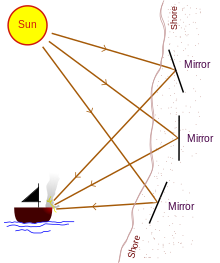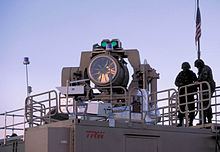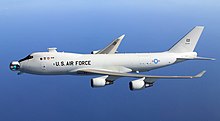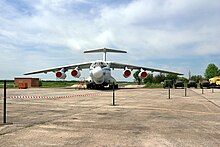A directed-energy weapon (DEW) is a ranged weapon that damages its target with highly focused energy, including laser, microwaves, and particle beams. Potential applications of this technology include weapons that target personnel, missiles, vehicles, and optical devices.
In the United States, the Pentagon, DARPA, the Air Force Research Laboratory, United States Army Armament Research Development and Engineering Center, and the Naval Research Laboratory are researching directed-energy weapons and railguns to counter ballistic missiles, hypersonic cruise missiles, and hypersonic glide vehicles. These systems of missile defense are expected to come online no sooner than the mid to late-2020s.
Russia, China, India and the United Kingdom are also developing directed-energy weapons while Iran and Turkey claim to have directed-energy weapons in active service. The first usage of directed-energy weapons in a combat was claimed to have occurred in Libya in August 2019 by Turkey, which claimed to use the ALKA Directed-energy weapon.
After decades of research and development, directed-energy weapons are still at the experimental stage and it remains to be seen if or when they will be deployed as practical, high-performance military weapons.
Operational advantages
Directed energy weapons could have several main advantages over conventional weaponry:
- Directed-energy weapons can be used discreetly; radiation above and below the visible spectrum is invisible and does not generate sound.
- Light is, for all practical purposes, essentially unaffected by gravity, windage and Coriolis force, giving it an almost perfectly flat trajectory. This makes aim much more precise and extends the range to line-of-sight, limited only by beam diffraction and spread (which dilute the power and weaken the effect), and absorption or scattering by intervening atmospheric contents.
- Lasers travel at light-speed and have near infinite range and are therefore suitable for use in space warfare.
- Laser weapons potentially eliminate many logistical problems in terms of ammunition supply, as long as there is enough energy to power them.
- Depending on several operational factors, directed-energy weapons may be cheaper to operate than conventional weapons in certain contexts.
Microwave weapons
Although some devices are labeled as microwave weapons, the microwave range is commonly defined as being between 300 MHz and 300 GHz, which is within the RF range—these frequencies having wavelengths of 1 millimeter to 1 meter. Some examples of weapons which have been publicized by the military are as follows:
- Active Denial System is a millimeter wave source that heats the water in a human target's skin and thus causes incapacitating pain. It was developed by the U.S. Air Force Research Laboratory and Raytheon for riot-control duty. Though intended to cause severe pain while leaving no lasting damage, concern has been voiced as to whether the system could cause irreversible damage to the eyes. There has yet to be testing for long-term side effects of exposure to the microwave beam. It can also destroy unshielded electronics. The device comes in various sizes, including attached to a Humvee.
- Vigilant Eagle is a proposed airport defense system that directs high-frequency microwaves towards any projectile that is fired at an aircraft. The system consists of a missile-detecting and tracking subsystem (MDT), a command and control system, and a scanning array. The MDT is a fixed grid of passive infrared (IR) cameras. The command and control system determines the missile launch point. The scanning array projects microwaves that disrupt the surface-to-air missile's guidance system, deflecting it from the aircraft.
- Bofors HPM Blackout is a high-powered microwave weapon that is said to be able to destroy at short distance a wide variety of commercial off-the-shelf (COTS) electronic equipment and is purportedly non-lethal.
- The effective radiated power (ERP) of the EL/M-2080 Green Pine radar makes it a hypothetical candidate for conversion into a directed-energy weapon, by focusing pulses of radar energy on target missiles. The energy spikes are tailored to enter missiles through antennas or sensor apertures where they can fool guidance systems, scramble computer memories or even burn out sensitive electronic components.
- AESA radars mounted on fighter aircraft have been slated as directed energy weapons against missiles, however, a senior US Air Force officer noted: "they aren't particularly suited to create weapons effects on missiles because of limited antenna size, power and field of view". Potentially lethal effects are produced only inside 100 meters range, and disruptive effects at distances on the order of one kilometer. Moreover, cheap countermeasures can be applied to existing missiles.
- Counter-electronics High Power Microwave Advanced Missile Project
Laser weapons
A laser weapon is a directed-energy weapon based on lasers.
Particle-beam weapons
Particle-beam weapons can use charged or neutral particles, and can be either endoatmospheric or exoatmospheric. Particle beams as beam weapons are theoretically possible, but practical weapons have not been demonstrated yet. Certain types of particle beams have the advantage of being self-focusing in the atmosphere.
Blooming is also a problem in particle-beam weapons. Energy that would otherwise be focused on the target spreads out and the beam becomes less effective:
- Thermal blooming occurs in both charged and neutral particle beams, and occurs when particles bump into one another under the effects of thermal vibration, or bump into air molecules.
- Electrical blooming occurs only in charged particle beams, as ions of like charge repel one another.
Plasma weapons
Plasma weapons fire a beam, bolt, or stream of plasma, which is an excited state of matter consisting of atomic electrons & nuclei and free electrons if ionized, or other particles if pinched.
The MARAUDER (Magnetically Accelerated Ring to Achieve Ultra-high Directed-Energy and Radiation) used the Shiva Star project (a high energy capacitor bank which provided the means to test weapons and other devices requiring brief and extremely large amounts of energy) to accelerate a toroid of plasma at a significant percentage of the speed of light.
The Russian Federation is developing plasma weapons.
Sonic weapons
Tests performed on mice show the threshold for both lung and liver damage occurs at about 184 dB. Damage increases rapidly as intensity is increased. Noise-induced neurological disturbances in humans exposed to continuous low frequency tones for durations longer than 15 minutes involved development of immediate and long-term problems affecting brain tissue. The symptoms resembled those of individuals who had suffered minor head injuries. One theory for a causal mechanism is that the prolonged sound exposure resulted in enough mechanical strain to brain tissue to induce an encephalopathy.
Long Range Acoustic Device (LRAD)
The Long Range Acoustic Device (LRAD) is an acoustic hailing device developed by LRAD Corporation to send messages and warning tones over longer distances or at higher volume than normal loudspeakers. LRAD systems are used for long-range communications in a variety of applications including as a means of non-lethal, non-kinetic crowd control.
According to the manufacturer's specifications, the systems weigh from 15 to 320 pounds (6.8 to 145.1 kg) and can emit sound in a 30°- 60° beam at 2.5 kHz.
History
Mirrors of Archimedes
According to a legend, Archimedes created a mirror with an adjustable focal length (or more likely, a series of mirrors focused on a common point) to focus sunlight on ships of the Roman fleet as they invaded Syracuse, setting them on fire. Historians point out that the earliest accounts of the battle did not mention a "burning mirror", but merely stated that Archimedes's ingenuity combined with a way to hurl fire were relevant to the victory. Some attempts to replicate this feat have had some success; in particular, an experiment by students at MIT showed that a mirror-based weapon was at least possible, if not necessarily practical. The hosts of MythBusters tackled the Mirrors of Archimedes three times (in episodes 19, 57 and 172) and were never able to make the target ship catch fire, declaring the myth busted three separate times.
Robert Watson-Watt
In 1935, the British Air Ministry asked Robert Watson-Watt of the Radio Research Station whether a "death ray" was possible. He and colleague Arnold Wilkins quickly concluded that it was not feasible, but as a consequence suggested using radio for the detection of aircraft and this started the development of radar in Britain.
The fictional "engine-stopping ray"
Stories in the 1930s and World War Two gave rise to the idea of an "engine-stopping ray". They seemed to have arisen from the testing of the television transmitter in Feldberg, Germany. Because electrical noise from car engines would interfere with field strength measurements, sentries would stop all traffic in the vicinity for the twenty minutes or so needed for a test. Reversing the order of events in retelling the story created a "tale" where tourists car engine stopped first and then were approached by a German soldier who told them that they had to wait. The soldier returned a short time later to say that the engine would now work and the tourists drove off. Such stories were circulating in Britain around 1938 and during the war British Intelligence relaunched the myth as a "British engine-stopping ray," trying to spoof the Germans into researching what the British had supposedly invented in an attempt to tie up German scientific resources.
German World War II experimental weapons
During the early 1940s Axis engineers developed a sonic cannon that could cause fatal vibrations in its target body. A methane gas combustion chamber leading to two parabolic dishes pulse-detonated at roughly 44 Hz. This sound, magnified by the dish reflectors, caused vertigo and nausea at 200–400 meters (220–440 yd) by vibrating the middle ear bones and shaking the cochlear fluid within the inner ear. At distances of 50–200 meters (160–660 ft), the sound waves could act on organ tissues and fluids by repeatedly compressing and releasing compressive resistant organs such as the kidneys, spleen, and liver. (It had little detectable effect on malleable organs such as the heart, stomach and intestines.) Lung tissue was affected at only the closest ranges as atmospheric air is highly compressible and only the blood rich alveoli resist compression. In practice, the weapon was highly vulnerable to enemy fire. Rifle, bazooka and mortar rounds easily deformed the parabolic reflectors, rendering the wave amplification ineffective.
In the later phases of World War II, Nazi Germany increasingly put its hopes on research into technologically revolutionary secret weapons, the Wunderwaffe.
Among the directed-energy weapons the Nazis investigated were X-ray beam weapons developed under Heinz Schmellenmeier, Richard Gans and Fritz Houtermans. They built an electron accelerator called Rheotron (invented by Max Steenbeck at Siemens-Schuckert in the 1930s, these were later called Betatrons by the Americans) to generate hard X-ray synchrotron beams for the Reichsluftfahrtministerium (RLM). The intent was to pre-ionize ignition in aircraft engines and hence serve as anti-aircraft DEW and bring planes down into the reach of the flak. The Rheotron was captured by the Americans in Burggrub on April 14, 1945.
Another approach was Ernst Schiebolds 'Röntgenkanone' developed from 1943 in Großostheim near Aschaffenburg. Richert Seifert & Co from Hamburg delivered parts.
Reported use in Sino-Soviet conflicts
The Central Intelligence Agency informed Secretary Henry Kissinger that it had twelve reports of Soviet forces using laser-based weapons against Chinese forces during the 1969 Sino-Soviet border clashes, though William Colby doubted that they had actually been employed.
Strategic Defense Initiative
In the 1980s, U.S. President Ronald Reagan proposed the Strategic Defense Initiative (SDI) program, which was nicknamed Star Wars. It suggested that lasers, perhaps space-based X-ray lasers, could destroy ICBMs in flight. Panel discussions on the role of high-power lasers in SDI took place at various laser conferences, during the 1980s, with the participation of noted physicists including Edward Teller.
Though the strategic missile defense concept has continued to the present under the Missile Defense Agency, most of the directed-energy weapon concepts were shelved. However, Boeing has been somewhat successful with the Boeing YAL-1 and Boeing NC-135, the first of which destroyed two missiles in February 2010. Funding has been cut to both of the programs.
Iraq War
During the Iraq War, electromagnetic weapons, including high power microwaves, were used by the U.S. military to disrupt and destroy Iraqi electronic systems and may have been used for crowd control. Types and magnitudes of exposure to electromagnetic fields are unknown.
Alleged tracking of Space Shuttle Challenger
The Soviet Union invested some effort in the development of ruby and carbon dioxide lasers as anti-ballistic missile systems, and later as a tracking and anti-satellite system. There are reports that the Terra-3 complex at Sary Shagan was used on several occasions to temporarily "blind" US spy satellites in the IR range.
It has been claimed (and proven false) that the USSR made use of the lasers at the Terra-3 site to target the Space Shuttle Challenger in 1984. At the time, the Soviet Union were concerned that the shuttle was being used as a reconnaissance platform. On 10 October 1984 (STS-41-G), the Terra-3 tracking laser was allegedly aimed at Challenger as it passed over the facility. Early reports claimed that this was responsible for causing "malfunctions on the space shuttle and distress to the crew", and that the United States filed a diplomatic protest about the incident. However, this story is comprehensively denied by the crew members of STS-41-G and knowledgeable members of the US intelligence community. After the end of the Cold War, the Terra-3 facility was found to be a low-power laser testing site with limited satellite tracking capabilities, which is now abandoned and partially disassembled.
Planetary defense
In the United States, the Directed Energy Solar Targeting of Asteroids and exploRation (DE-STAR) Project was considered for non-military use to protect Earth from asteroids.
Non-lethal weapons
The TECOM Technology Symposium in 1997 concluded on non-lethal weapons, "determining the target effects on personnel is the greatest challenge to the testing community", primarily because "the potential of injury and death severely limits human tests".
Also, "directed-energy weapons that target the central nervous system and cause neurophysiological disorders may violate the Certain Conventional Weapons Convention of 1980. Weapons that go beyond non-lethal intentions and cause 'superfluous injury or unnecessary suffering' may also violate the Protocol I to the Geneva Conventions of 1977."
Some common bio-effects of non-lethal electromagnetic weapons include:
- Difficulty breathing
- Disorientation
- Nausea
- Pain
- Vertigo
- Other systemic discomfort
Interference with breathing poses the most significant, potentially lethal results.
Light and repetitive visual signals can induce epileptic seizures. Vection and motion sickness can also occur.
Cruise ships are known to use sonic weapons (such as LRAD) to drive off pirates.
Russia has been reportedly using blinding laser weapons during its military intervention in Donbass.






